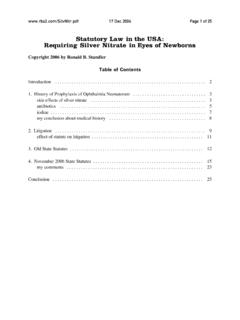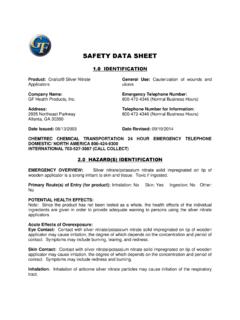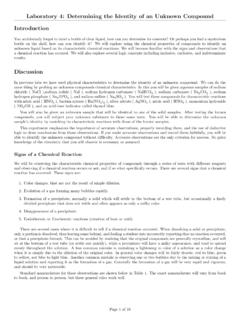Transcription of BALANCED EQUATIONS - Arbuiso.com
1 REACTI0N. BOX. BALANCED EQUATIONS . PHASE SYMBOLS MANDATORY IN ALL BALANCED EQUATIONS . A Na2CO3(AQ) + CuSO4(AQ) CuCO3(S) + Na2SO4(AQ). B Na2CO3(AQ) + Mg(NO3)2(AQ) MgCO3(S) + 2 NaNO3(AQ). C Na2CO3(AQ) + Co(NO3)2(AQ) 2 NaNO3(AQ) + CoCO3(S). D 2Na3PO4(AQ) + 3 CuSO4(AQ) 3Na2SO4(AQ) + Cu3(PO4)2(S). E 2Na3PO4(AQ)+ 3Mg(NO3)2(AQ) 6 NaNO3(AQ) + Mg3(PO4)2(S). F 2Na3PO4(AQ) + 3Co(NO3)2(AQ) 6 NaNO3(AQ) + Co3(PO4)2(S). G 2 NaOH(AQ) + CuSO4(AQ) Na2SO4(AQ) + Cu(OH)2(S). H 2 NaOH(AQ) + Mg(NO3)2(AQ) 2 NaNO3(AQ) + Mg(OH)2(S). I 2 NaOH(AQ) + Co(NO3)2(AQ) Co(OH)2(S) +2 NaNO3(AQ). J** Ca(OH)2(AQ) + CuSO4(AQ) CaSO4(S) + Cu(OH)2(S). K Ca(OH)2(AQ)+Mg(NO3)2(AQ) Ca(NO3)2(AQ)+Mg(OH)2(S). L Ca(OH)2(AQ)+Co(NO3)2(AQ) 2Ca(NO3)2(AQ)+Co(OH)2(S). REACTI0N. BOX ALL of the WORD EQUATIONS . A Sodium carbonate + Copper (II) sulfate Copper (II) carbonate + Sodium sulfate B Sodium carbonate + Magnesium nitrate Magnesium carbonate + Sodium nitrate C Sodium carbonate + Cobalt (II) nitrate Sodium nitrate + Cobalt (II) carbonate D Sodium phosphate + Copper (II) sulfate Sodium sulfate + Copper (II) phosphate E Sodium phosphate + Magnesium nitrate Sodium nitrate + Magnesium phosphate F Sodium phosphate + Cobalt (II) nitrate Sodium nitrate + Cobalt (II) phosphate G Sodium hydroxide + Copper (II) sulfate Sodium sulfate + Copper (II) hydroxide H Sodium hydroxide + Magnesium nitrate Sodium nitrate + magnesium hydroxide I Sodium hydroxide + Cobalt (II) nitrate Cobalt (II) hydroxide + Sodium nitrate J Calcium hydroxide + Copper (II) sulfate Potassium sulfate + Copper (II)
2 Chromate K Calcium hydroxide + magnesium nitrate magnesium hydroxide + calcium nitrate L Calcium hydroxide + Cobalt (II) hydroxide Calcium nitrate + Cobalt (II) hydroxide Conclusion for Precipitate Lab There are 6 main indicators of a chemical reaction, shortened to remember to TOPIC-B. Temperature change, odor change, precipitate formation, irreversibility, color change, and new bubble formation are the evidence for a chemical reaction occurring. Not every time one of these changes is proof of a chemical reaction, but often they are. Sometimes chemical reactions can occur with no obvious evidence from TOPIC-B. Precipitates occur when a double replacement reaction happens. To start, you need 2 aqueous solutions. Aqueous means that the compound is dissolved in WATER. If we put many ionic compounds in water, the ions separate (the water has the ability to separate them from each other) and in solution are both cations and anions floating around.
3 This is a phase change, from solid to aqueous. This part is NOT a chemical reaction, even though sometimes this process makes a temperature change (table I has several examples like this with H values). Evaporating the water results in a return to the ionic compound solid, which is a physical change. When we mix these two sets of ions floating in water, sometimes a cation and anion are so attracted together, they bond into a solid, and sink to the bottom of the beaker. To determine which cation-anion pair forms the solid precipitate, we use table F on the reference tables. This table will tell us if an ionic compound will be aqueous (dissolved invisibly) or if it is insoluble (not able to dissolve into water, or, it forms a solid precipitate). If the results of putting 2 aqueous solutions together results in the formation of 2 new aqueous solutions, without a precipitate forming, no reaction really occurred.
4 Rather - you just mixed the 2 solutions together, making a homogenous mixture (the same throughout, mixed, but with no new properties). Without a precipitate, no double replacement reaction happened. If you start with only one aqueous solution, and an atom (or HONClBrIF twin), that is the set up for a single replacement reaction. We use table J for that type of reaction. Synthesis has 2 or more small substances combining into one larger product. Decomposition is just the reverse of synthesis. One larger reactant forms 2 or more products. Combustion always has a hydrocarbon (compound with just hydrogen + carbon) combining rapidly with oxygen, always forming carbon dioxide and water. Sometimes we'll see an oxygenated hydrocarbon molecule combusting too. An oxygenated hydrocarbon contains hydrogen and carbon and oxygen, examples of those are sugars, alcohols, or ethers.
5 Combustion reactions are always exothermic, always, and very. I love chem, the end. Six Lab Questions ANSWERS. 1. Write the word equation for the reaction in box C. Sodium carbonate and copper (II) nitrate solutions form into sodium nitrate solution and copper (II) carbonate solid (precipitate). 2. Describe in some detail (include a diagram if necessary) to explain what happens when sodium chloride solid is put into water. What actually happens to the solid when an ionic compound dissolves in water? When any ionic compound that can dissolve into water goes into water, the water is able to rip apart the ions of sodium from chloride, and then these ions float detached from each other (but still in their 1:1 ratio) in the water. This solution is water with millions of loose positive sodium ions and negative chloride ions. The solid disappears because the ions are smaller by far, than anything your eyes can see.
6 3. How would you explain how table sugar (sucrose) dissolves into water? It is molecular, and forms NO IONS. Sugar and other molecular compounds that can dissolve in water are also broken apart, but only to the molecular level. Each sucrose molecule is separated from the others by the water, but the molecules are still there in between the water molecules. They are also too small for the eye to see. 4. If you were to put some silver chloride into water, why would it NOT dissolve? This solid is NOT aqueous, the ions are so strongly attracted together that the water cannot separate them. They do not dissolve, and therefore just fall to the bottom of the beaker (like sand) and remain solid in the water. They form no ionic solution, and this would not be an electrolyte either. 5. Write a BALANCED chemical equation with phases for the reaction between ammonium phosphate and niobium (V) nitrate solutions.
7 5(NH4)3PO4(AQ) + 3Nb(NO3)5(AQ) 15NH4NO3(AQ) + Nb3(PO4)5(S). 6. Write a BALANCED chemical equation with phases for the reaction between lead (IV) acetate and sodium bromide solutions. Pb(C2H3O2)4(AQ) + 4 NaBr(AQ) 4Na(C2H3O2)(AQ) + PbBr4(S).






